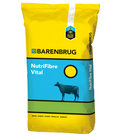Total approach works against grubs
Grubs can cause serious damage on dry sandy soils. Irrigate, compact the ground and opt for a soft-leaf tall fescue to keep the damage manageable.
Source: Veeteelt GRAS

Grubs can cause serious damage on dry sandy soils. Irrigate, compact the ground and opt for a soft-leaf tall fescue to keep the damage manageable.
Source: Veeteelt GRAS
Drought, light sandy soils and grubs. This is a disastrous combination for turf. In the past two summers, Klaas van Rozen, technical researcher in pest insects at Wageningen University & Research, also received various reports of damage by grubs that became more apparent due to the drought. ‘The extent of the damage varies by year, region and even on different plots,’ explains Van Rozen. He is Project Leader of a grub study that started in 2017. ‘There are no permitted chemical pesticides against grubs, while the negative impact on yield can amount to fifty percent.’ The practice or research must clarify which other methods are effective in limiting the damage. 'These grubs are larvae of scarab beetles (Scarabaeidae), ' Van Rozen tells us, to clarify the necessary basic knowledge. 'There are several types of these beetles in the Netherlands, ten of which cause damage. Cockchafers (Melolontha melolontha) and garden chafers (Phyllopertha horticola) cause the most damage by far. These beetles lay their eggs in the grass In May and June. The eggs develop into larvae that feed on grass roots just below the surface. The damage that this will cause will become really visible from August onwards.

Grubs can cause significant damage to the turf.
'In the case of the cockchafer grubs, we saw that more than fifty percent died through compacting.'
Grass plants with root damage are extra sensitive during dry periods, which is why irrigation in summer is one of the options for limiting the damage. Rolling or compacting the turf also seems to have a favourable effect. 'When you do that at the right time, you not only ensure that the remaining plant root regains contact with the soil, you also kill grubs,' in Van Rozen's experience. 'In the case of the cockchafer grubs, we saw that more than fifty percent died through compacting.' Rotavating the turf intensively is even more effective. ‘This will destroy more than 80% of the grubs. It does mean that you have to renew the turf, but you start again with cleaner soil.'
|
Cockchafer grub |
Percentage soil coverage | |
| Perennial ryegrass | 12.2 | 65 |
| Soft-leaf tall fescue | 1.9 | 88 |
Number of grubs and grass cover per square meter (source: Wageningen University & Research)
The research programme includes trial fields with different grass species and varieties. It is striking that soft-leaf tall fescue is less susceptible to grub damage than ryegrasses or festulolium. 'Drought also plays a role, but in the test field with mainly cockchafer grubs, significantly fewer grubs were found in plots with soft-leaf tall fescue than with perennial ryegrass,' says Van Rozen. Characteristically, Tall fescue has a compact root system,' adds Suzan Nicolasen, development & innovations manager at Barenbrug. Barenbrug is involved in the research programme of Wageningen University & Research and has also set out test fields itself. 'It seems that the cockchafer and garden chafer are less likely to lay their eggs in soft-leaf reed fescue,' continues Nicolasen. 'We also see differences within the species. That is why we have continued to focus on leaf softness, plant health and initial development through breeding efforts with the tall fescue. The Vital mixture has been formulated using these latest genetics.'
Van Rozen decides that you have to follow a 'targeted total approach' to combat grubs. 'Grubs will always remain in sandy grassland, but you can to keep the damage manageable by using various measures at the right time .'
Tall fescue's compact root system helps to keep grub damage lower than it would be with ryegrasses. VeeteeltGRAS, working in a collaboration with Barenbrug, describes how the total approach keeps grub damage manageable.
